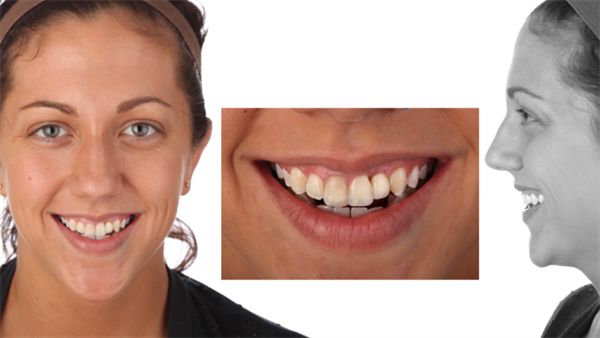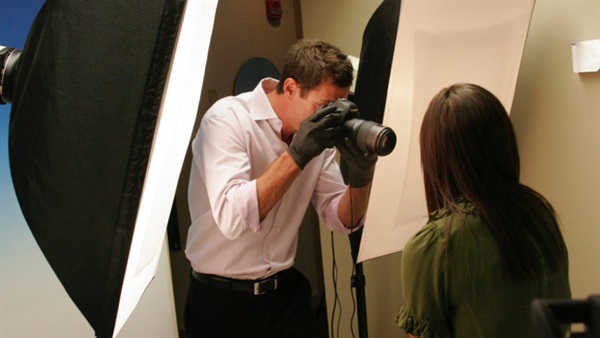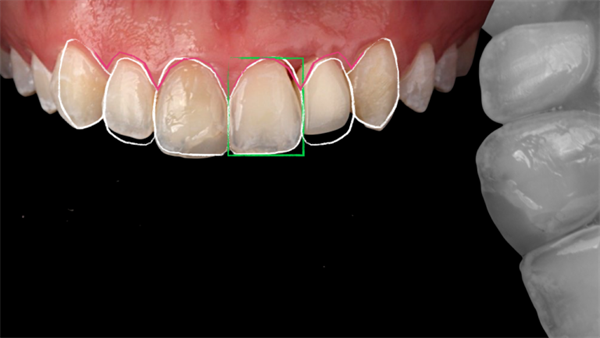By: Dr. Jason Olitsky
 Case Study:
Case Study:
"The most critical factor is treatment planning or
starting a case with the end"
There are many factors that contribute to aesthetic success
or failure. It’s not uncommon for many of my patients to enter
treatment while experiencing some form of failure,
past or present. Kelsey is one of those patients. At 24 years old, she had childhood trauma that resulted in missing tooth #10 and
 endodontic therapy on tooth #8. She came to me after having an implant and provisional restoration placed and soft tissue augmentatio in the #10 site that failed. With a significant
endodontic therapy on tooth #8. She came to me after having an implant and provisional restoration placed and soft tissue augmentatio in the #10 site that failed. With a significant
soft tissue defect, she was unhappy with the overall aesthetics not only of the temporary implant crown, but her smile.
"No matter what stage a patient enders my care, I treatment plan with the end in mind"
This begins with a patient consultation which include detailed pictures and videos to discuss the patient’s immediate concerns as well as my concerns with the teeth and smile. The relevant principles of smile design are reviewed with the patient and we discuss how her immediate concern is impacting her smile and treatment techniques available to correct her concerns. Treatment options are given with the associated benefits and risks, as well as pictures of other patients who have underwent similar procedures along with their stories. The patient is given the

information necessary to make an educated decision. In order to adequately address Kelsey’s concerns as well as mine, I perform a comprehensive exam, including full series of X-rays, head, neck, muscle and functional exam with a series of photographs in addition to video to evaluate phonetics, lip movement and reflective and deflective zones.
After a I preformed a comprehensive exam, my findings where as follows:
– Stable TMJ
– Normal range of motion
– Normal Muscle testing
– No headaches, awareness of parafunction, or wear.
– Root blunting from orthodontics
– Mild gingivitis
– Caries
The Patient’s primary concern was the aesthetic aspect of her smile, specifically making her new implant crown replacing tooth #10 as natural looking as possible. Treatment planning begins with a review of facial aesthetics and labiodental dynamics to determine ideal incisal edge position, incisal plane and tooth position. A restorative plan is developed using Digital Smile Design techniques as a visual guide for patient and laboratory communication. The patient’s prominently high smile line put a relatively high importance on the gingival defect and would cause potentially an obvious gingival asymmetry in her smile. Since she had already attempted a soft tissue graft that failed, most likely to the buccal implant position, grafting was ruled out as an option.
"Would this mean aesthetic failure?"

Instead, it may mean creative treatment planning. I presented veneers on teeth ##5,6,7,8,9,11,12 and porcelain implant crown on #10 with pink porcelain/composite combination to mask the defect. The combination of pink porcelain and composite would allow for the closest gingival replication to occur in this high smile line case.


We used slight laser re-contouring to establish gingival symmetry, then I prescribed a diagnostic wax up. This wax-up was used to create her new smile in Bis-Acry provisional material as a prototype of the final restorations. We could then both temporize her new smile and utilize pink composite to the match her tissue in the provisionals. The pink composite color was sent to the laboratory (Gold Dust Dental Lab) to assist in matching the pink porcelain in the final restoration.
This mix of composite with the pink porcelain substructure was able to adequately mask the defect while allowing the rest of her smile to reach our goals for incisal length, shapes, shade and morphology.
Sometimes, we can get stuck thinking we have to “manage” failures presented to us. In this case, we were able to create a result that even exceed the patient’s expectations!